Break the Gap is much more than an event. It is a program driven by GooApps® and Goo Ventures that was created with the objective of accelerating innovative solutions in the fields of health and sports. Two sectors in which technology has a direct impact on people’s lives and where there are still many barriers to overcome.
“Only 1 out of every 4 startups manages to move from idea to market.”
This is the reason why Break the Gap was created, to break this statistic by providing the tools and support needed for startups with innovative solutions that deserve to reach the market.
In addition, Break the Gap seeks to close two gaps. The first is the gender gap, by encouraging more women to lead technology projects and to gain visibility in an ecosystem where their presence is still unequal. The second is the gap in the implementation of innovation, because a brilliant idea is of little use if it does not reach the market and does not translate into implementable solutions for hospitals, patients, high-performance centers, or athletes, among others.
In this 2025 edition, Break the Gap took a step further and expanded its format into two independent verticals. One final focused on health and another on sports. Each final day was held in an iconic venue in Barcelona and brought together finalist startups, the jury, mentors, speakers, and investors. At stake, 50,000 euros in equity investment for the winner of each vertical, provided by Goo Ventures.
But the finals of the event were not the starting point, but the culmination of a long journey. In the weeks prior, the eight finalist teams, four per vertical, participated in an acceleration program valued at 10,000 euros, where they received mentoring from top-level experts in health and sports. This support allowed them to refine their proposals, validate the business approach, and arrive at the grand final prepared to defend their vision before the jury.
Beyond the winning projects, the true richness of the event lay in what happened during the final days. The presentations that inspired the teams, the pitches from the finalists passionately defending their projects, and the questions from the jury, which served as a guide to measure the potential of each proposal. Not to forget the networking sessions, which are already showing their fruits in future collaborations.
And what lessons did these two days leave us?
In the following sections, we will review the most outstanding aspects of the health and sports finals, with their protagonists and the projects of this edition, which demonstrated a level of excellence to remember.
An event held in iconic venues across Barcelona
Dates and venues
The final of the health vertical was held on September 9 at the Barcelona Health Hub, located in the Recinto Modernista de Sant Pau. A space that has already become a European benchmark in healthcare innovation.
The following day, on September 10, it was the turn of the sports vertical, which took place at The Venue Barcelona, inside the Estadi Olímpic Lluís Companys, a venue with a strong symbolic significance for the sports ecosystem.
Project evaluation criteria
The jury analyzed each project under five very clear parameters:
- Problem: relevance and clarity in defining the need to be solved.
- Viability: technical and business feasibility.
- Pilot: initial testing and validation in real environments.
- Scalability: ability to grow in market and users.
- Team: preparation, commitment, and complementarity of the founders.
Who attended the event?
Break the Gap 2025 was a meeting point for emerging startups, but also for professionals from the health and sports sectors, public administrations interested in applied innovation, and investment funds looking for projects with potential market success. This mix of profiles is what made the interaction at both final days so rich.
A health final filled with industry leaders
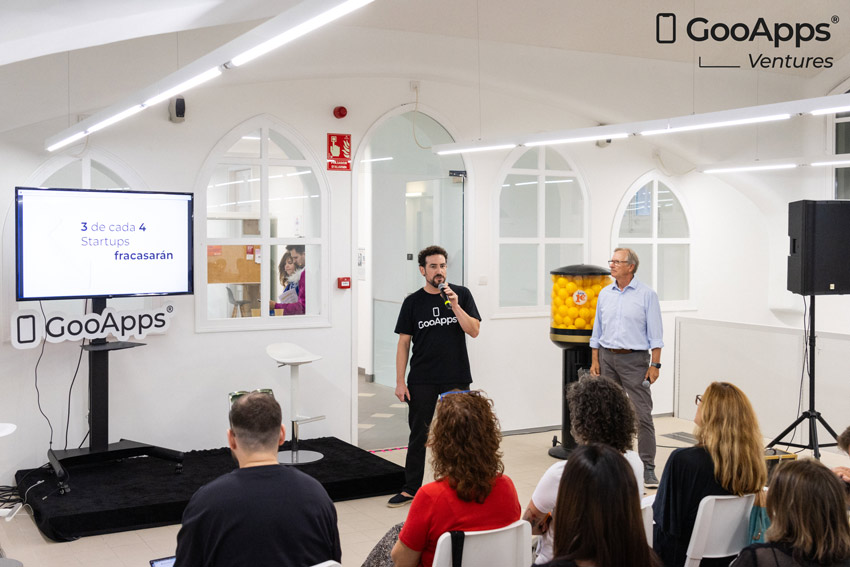
Eric García, CEO of GooApps® and Goo Ventures
The day began at the Barcelona Health Hub, with an auditorium full of representatives from hospitals, universities, startups, mentors, the jury, collaborating entities, investors, and specialized media. From the very start, it was clear that the final was going to be more than just a competition. It was a space to validate talent, build networks, and accelerate innovation.
Eric García, CEO of GooApps® and Goo Ventures, opened the event with a direct message:
“Three out of four startups will fail. We are here to change that statistic.”
He then explained the purpose of Goo Ventures, a venture studio focused on supporting startups in their early stages with funding, technology, and networks, so that ideas can become market-ready solutions.
Eric took the opportunity to thank all the entities that have supported Break the Gap since its inception. He expressed his gratitude to Barcelona Health Hub for hosting the final at the Recinto Modernista de Sant Pau and to the collaborating institutions such as the Institut d’Investigació i Innovació Parc Taulí (I3PT), integrated into the network, Hospital Germans Trias i Pujol, Universitat de Barcelona (UB), Universitat Politècnica de Catalunya (UPC) and the European Institute of Innovation and Technology (EIT Health). In addition, he highlighted sponsors and collaborating entities such as Gijón Impulsa, Fundación Once, the Instituto Ramón y Caja de Investigación Sanitaria (IRYCIS), the Institut de Investigació Sant Pau, Diario Salud and Codepa.
His final message was a reminder of the ultimate purpose of the entire program:
“Now more than ever, human connections matter. We create technology by and for people.”
After him, Luis Badrinas, vice president of Barcelona Health Hub, took the floor. In his speech, he highlighted how the Hub has become established as a meeting point between startups, hospitals, companies, and investors, and emphasized the relevance of events such as Break the Gap to break down barriers and accelerate the transfer of innovation to the healthcare system.
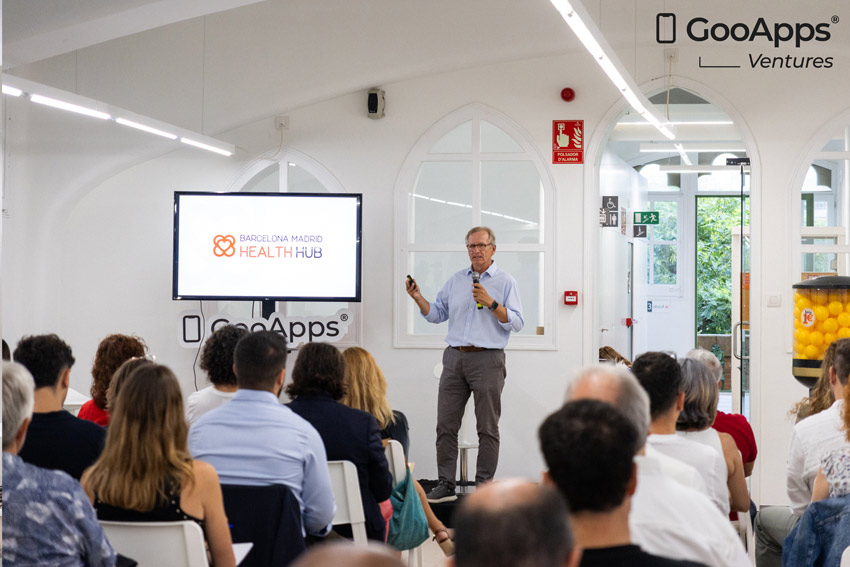
Luis Badrinas, vice president of Barcelona Health Hub
Luis reminded everyone that the mission of the Hub is to connect talent with the existing needs of the healthcare sector and that the value of this type of competition lies in bringing together entrepreneurs, clinicians, and investors for a common goal. His closing message was a call for the finalist projects to always think of the patient as the center, because that is where innovation truly makes sense.
From healthcare centers to the market, innovation with ITEMAS
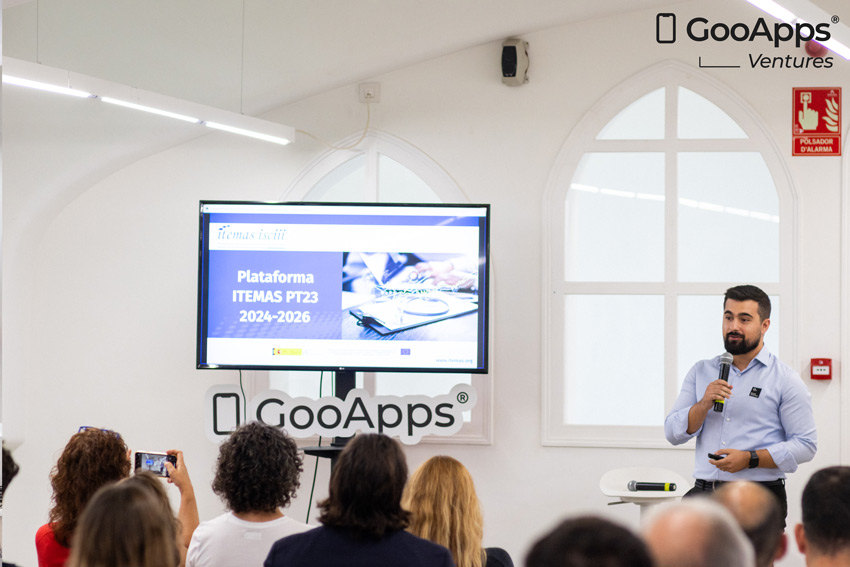
Martín León, Head of Innovation at I3PT and coordinator of ITEMAS–ISCIII
After the institutional welcome at the health final, Martín León, Head of Innovation at the Institut d’Investigació i Innovació Parc Taulí (I3PT) and internal coordinator of the ITEMAS–ISCIII platform
, took the floor. His keynote was titled: “From healthcare centers to the market, ITEMAS platforms accelerate innovation throughout the territory.”
Martín focused his presentation on the importance of the role that healthcare centers play as engines of innovation, highlighting that much of the talent and the most disruptive ideas are born in hospitals and laboratories, but often get stuck in those early stages. Martín explained that it is essential to have platforms like ITEMAS, which act as a bridge between clinical research and the market.
During his talk, he highlighted the following aspects:
- Transparency and technology transfer. Innovation cannot remain locked in scientific publications; it must be transformed into products and services accessible to patients and professionals.
- Connection with the productive fabric. The business ecosystem needs to be closer to hospitals in order to turn clinical needs into business opportunities.
- Territorial scalability. ITEMAS, as a national healthcare innovation network, ensures that projects do not remain isolated initiatives, but can be replicated and scaled throughout the territory.
Martín León emphasized about ITEMAS that “with a trajectory focused on promoting the transfer of healthcare technology, our goal is for innovation not to remain in laboratories, but to reach the market and transform people’s lives.”
High level of innovation from the four health finalist projects
After the institutional welcome and the keynote by Martín León, the central block of the day arrived with the pitches of the four finalist projects. Each team had a few minutes to present their proposal, show how they had worked during the acceleration program, and answer the jury’s questions. Below, we review each initiative in detail.
CON-TACTO
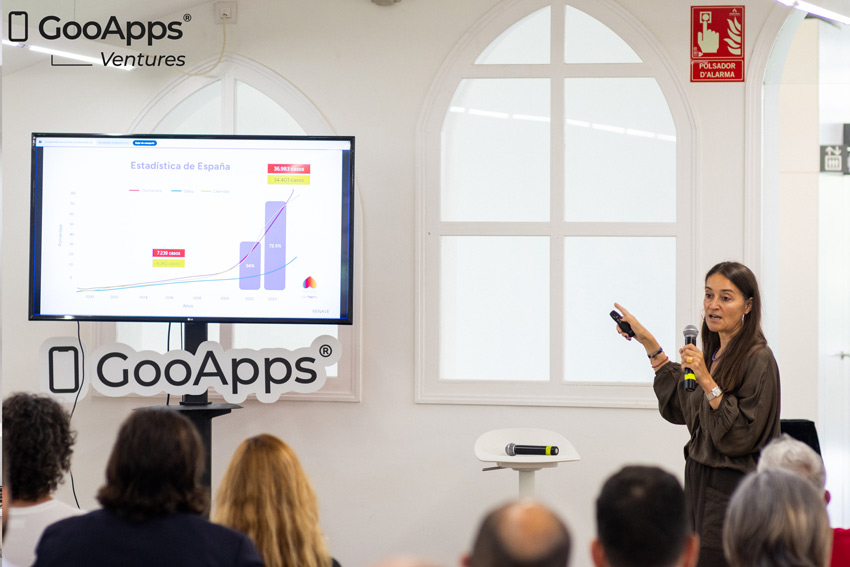
Dr. Mac Navarro Sáez
The first team to take the stage was CON-TACTO, an innovative solution aimed at the prevention and early diagnosis of sexually transmitted infections (STIs). Their proposal focuses on a platform that allows individuals to anonymously notify potential contacts when a person receives a positive diagnosis, facilitating early screening and reducing the chain of contagion.
The team is composed of Dr. Mac Navarro Sáez and Dr. Marta Navarro Vilasaró, specialists in HIV and STIs from Hospital Universitari Parc Taulí, Dr. Sonia Calzado Isbert and Dr. Félix Straga Napolitano,
experts in infectious diseases; and two anonymous PrEP users who contribute their personal experience in sexual health, activism, and app testing. This combination of medical expertise, community focus, and digital awareness strengthens the project’s credibility and its potential for implementation in hospitals and healthcare centers.
During their presentation, they stressed that one out of every two STIs is not diagnosed in time, which increases the risk of complications and spread. CON-TACTO seeks to address this gap with a simple-to-use digital tool, integrated into healthcare workflows and fully aligned with data protection and patient privacy.
The pitch focused on two main aspects. On the one hand, the public health impact that such a solution would have by reducing the incidence of STIs in young and adult populations, and, on the other hand, the ease of adoption by hospitals and healthcare centers, which could integrate it as another screening resource within their protocols.
As explained by Dr. Mac Navarro during her presentation, “our objective is twofold: to improve early detection and, at the same time, to support the patient by giving them a safe and anonymous tool to notify their contacts.”
MyMind
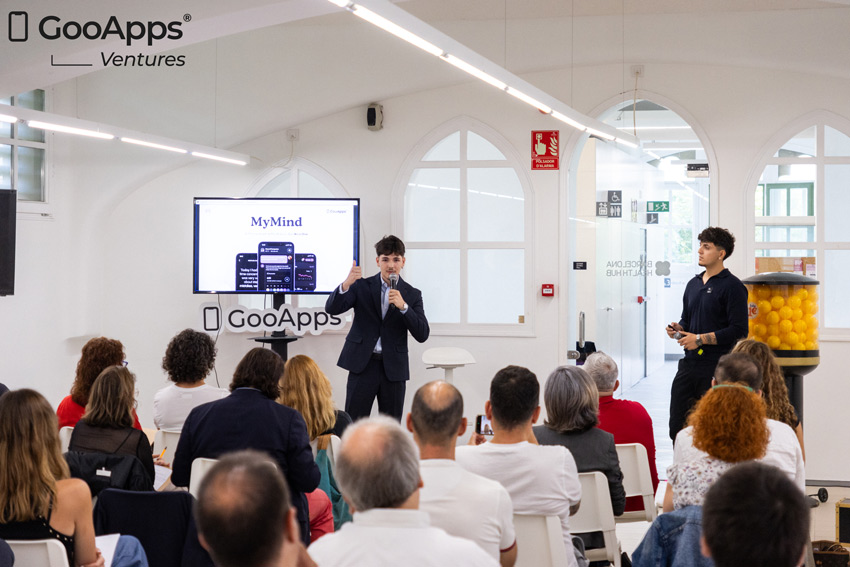
Daniel Sánchez Marcos and Yeray Maarar López
The second finalist team was MyMind, a digital solution focused on prevention and psychological support for young people. Their proposal combines artificial intelligence with validated psychological support techniques to detect early signs of anxiety, depression, or other mental health issues that often go unnoticed during adolescence and youth.
The team is composed of Daniel Sánchez Marcos (CEO) and Yeray Maarar López (COO), entrepreneurs with experience in technology, freemium models, and digital product development, accompanied by a clinical team of psychologists who train and supervise the AI. Their shared vision is to bring mental health closer to young people through a language and format that feels natural to them.
During the pitch, the founders of MyMind highlighted a concerning statistic: more than 50% of mental health disorders begin before the age of 14, yet most do not receive specialized care until years later. To reduce this gap, they presented an application that allows young people to interact with an AI-based conversational assistant, designed to perform an initial emotional screening and recommend professional mental health care when necessary.
The application also offers preventive resources: mindfulness exercises, emotion management techniques, and self-care routines adapted to the user’s profile. It also includes an alert system that can trigger psychologist intervention if risk indicators are detected.
Daniel Sánchez, during his presentation, said: “We want to give young people a tool that feels close to them, that speaks their same language, and that acts as a bridge to professional help before it is too late.”
QGuard Med
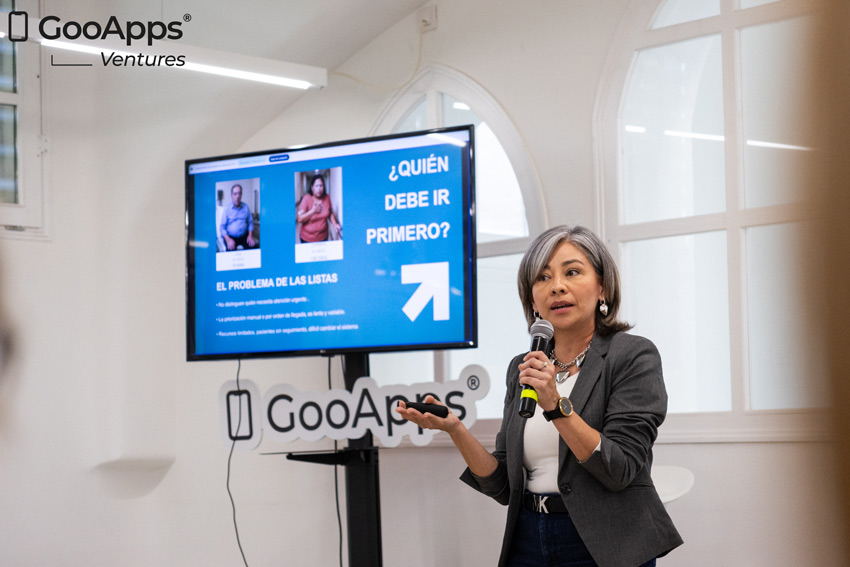
Dr. Jessica Ortiz
The third finalist team was QGuard Med, a technological solution designed to address one of the major problems in the healthcare system: waiting lists. Their proposal focuses on an intelligent management system that uses artificial intelligence and predictive algorithms to allocate resources more efficiently and reduce patient waiting times.
The team is led by Dr. Jessica Ortiz, a physician with experience in clinical innovation, cardiovascular risk, digital health, and nutrition, and Dr. Antonio Esquivel,
a physician with expertise in AI applied to the clinical and scientific field, specializing in redox markers associated with the progression of heart failure. This combination of profiles allows them to cover both the clinical and the technological-operational aspects of the project.
In their pitch, QGuard Med shared a fact about the current situation: in some hospitals, waiting times for consultations or surgeries can exceed six months, which not only generates frustration among patients but also poses health risks. To tackle this, they propose a system that integrates historical data, clinical variables, and resource availability to optimize the allocation of appointments and operating rooms.
The platform offers hospitals a real-time control panel that allows them to foresee bottlenecks, reorganize schedules, and prioritize urgent cases with objective criteria. In addition, it includes a patient communication module to keep patients informed and reduce absenteeism rates.
As Jessica Ortiz explained during the presentation: “Our objective is that no patient waits longer than necessary. With data and artificial intelligence, we can reorganize the system in a fair and efficient way.”
RheumaLink
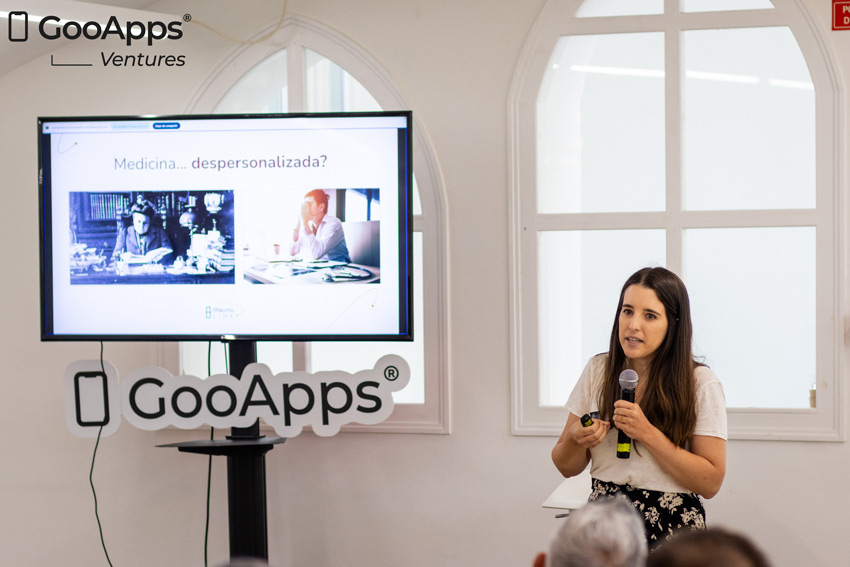
Dr. Sílvia Garcia-Cirera
The last team to present their pitch was RheumaLink, a digital solution focused on the remote monitoring of patients with rheumatological diseases. The project’s objective is to improve the follow-up of people suffering from arthritis, lupus, or other chronic conditions, enabling specialists to monitor the patient’s progress without the need for constant in-person visits.
The team is led by Dr. Sílvia Garcia-Cirera, rheumatologist and researcher at the I3PT Institute. Alongside her are clinical experts such as Dr. Joan Calvet Fontova, Dr. Eduard Graell Martin and Dr. Maria Llop Vilaltella, as well as Cristina Aymerich Mañas (nursing), Gerard Badia Arderiu (data engineering), Anna Carreras Nolla and Clara Feliu Hernández
(scientific project management). This multidisciplinary team combines healthcare experience, research, and technological development.
During their presentation, the members of RheumaLink explained that many patients with rheumatological diseases experience unpredictable flare-ups that are not always detected in time. This leads to delays in treatment and an increase in complications. To address this challenge, their platform proposes a mobile application where patients record symptoms, pain levels, and quality of life, paired with a clinical panel that allows physicians to receive automatic alerts when the data indicates worsening conditions.
The solution also incorporates teleconsultation tools and patient education resources, with personalized materials and routines designed to empower patients in the management of their disease.
As Dr. Sílvia Garcia-Cirera explained during the pitch: “With RheumaLink, we want doctors to have eyes and ears in the daily lives of their patients, so they can intervene before a flare-up worsens.”
From the award to the MVP: the journey of La Ruta Azul
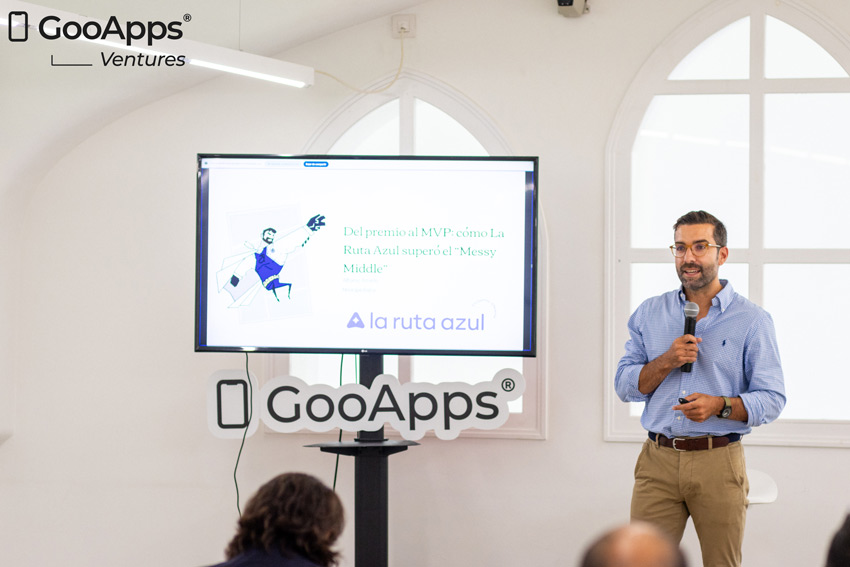
Alfonso Amado
After the project presentations, the day offered another keynote full of high-value content for startups.
The keynote was delivered by Alfonso Amado, founder of La Ruta Azul.
Under the title “From the award to the MVP”, he shared the experience of how a project awarded in a previous edition managed to overcome the early stages of uncertainty and build a validated minimum viable product (MVP).
The speakers emphasized that the journey between winning a competition and having a market-ready product is complex and full of what they described as the “messy middle”, that period in which the idea must be transformed into a real service, with users, metrics, and first clients.
Among the most relevant learnings, they highlighted three main aspects:
- Focus on the user: validating the problem directly with patients and clinical professionals.
- Rapid iteration: not waiting to have the perfect product, but testing early and adjusting.
- Support network: surrounding oneself with mentors, partners, and entities that accelerate the journey.
Alfonso wanted to highlight that “the award is only a starting point. What matters is the ability to turn that visibility into a product that works and has a market.”
The project that won €50,000 in the health category
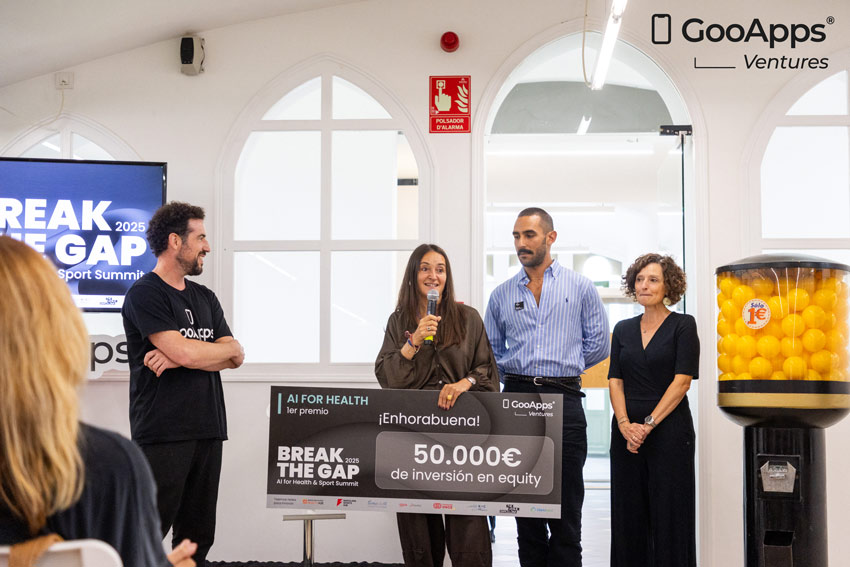
After the pitches of the four finalists, the most anticipated moment of the day arrived. While the teams and the rest of the attendees enjoyed the keynotes, the panel of experts that made up the jury met behind closed doors to evaluate each proposal according to the five established criteria: problem, viability, pilot, scalability, and team.
The decision was not easy. Each project had shown a clear and defined approach, along with a strong commitment to solving current challenges in the healthcare field. However, the jury could only choose one winner.
That project was CON-TACTO, which emerged as the winner of the health vertical and received an equity investment of €50,000 from Goo Ventures. The jury valued the fact that its solution directly addressed an underrecognized problem, sexually transmitted infections, with an innovative, viable, and easily integrable approach in clinical practice. In addition, the team demonstrated solid clinical experience and a clear roadmap to scale the tool in hospitals and healthcare centers.
When the verdict was announced, the spokesperson of the team, Dr. Mac Navarro Sáez, expressed her excitement with words that reflected the spirit of the day:
“This recognition drives us to bring CON-TACTO to more hospitals. Our challenge is to reduce the transmission of STIs, and we believe this investment is the decisive step to achieve it.”
The auditorium responded with a long round of applause, recognizing the winning team, but also all the finalists who had demonstrated the talent and diversity of the HealthTech ecosystem.
Breaking boundaries at the sports final event
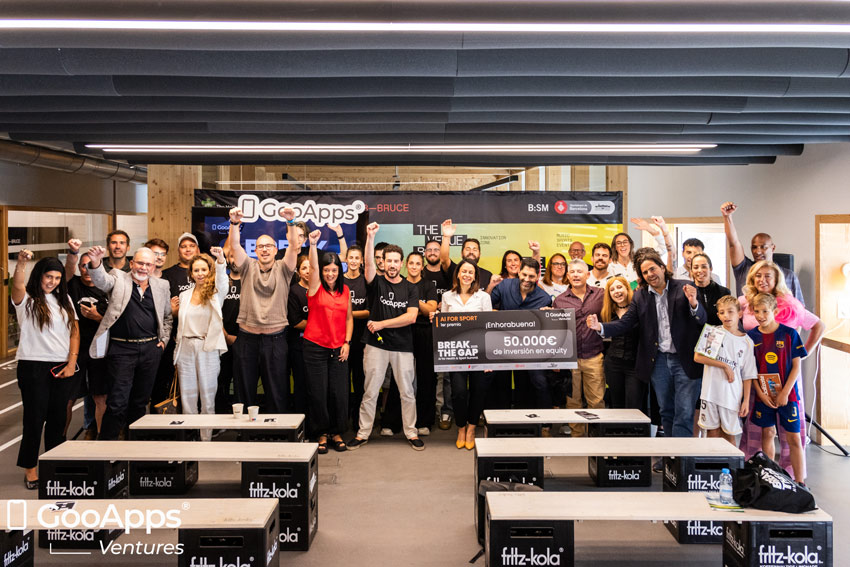
The second day of Break the Gap 2025 was held in an emblematic location in Barcelona: the Estadi Olímpic Lluís Companys, at The Venue Barcelona, a hub that has positioned itself as a meeting point for sports projects, music, and major events. The atmosphere that morning reflected that mix of sports history and forward-looking vision that characterizes the event.
The opening was led by Eric García, CEO of GooApps® and Goo Ventures, accompanied by Xavier Trallero Guillot, director of the Barcelona Sports Hub, and Daniel Duemig, co-founder of The Venue Barcelona.
Eric began the welcome by explaining how Goo Ventures works to co-create startups in the verticals of health, sports, and wellness, providing not only technological expertise in AI, mobile, and data analytics, but also funding, resources, and a network of contacts that includes pharma, hospitals, universities, research centers, and, in this case, sports centers.
In his acknowledgments, Eric mentioned the institutions that were making the day possible: the Barcelona Sports Hub, a driving force for sports innovation in the city, and The Venue Barcelona, which hosted the gathering at the Olympic Stadium.
After his speech, Daniel Duemig, co-founder of The Venue Barcelona, spoke about the unique value of this space, which he described as “the hub of hubs,” where organizations such as the Association of Manufacturers and Distributors of Sporting Goods (AFYDAD), the International Paddle Cluster, and the organizers of the Paddel World Summit coexist. He emphasized that The Venue has become a unique sandbox for testing new technologies in an environment with more than 160 annual events and thousands of attendees.
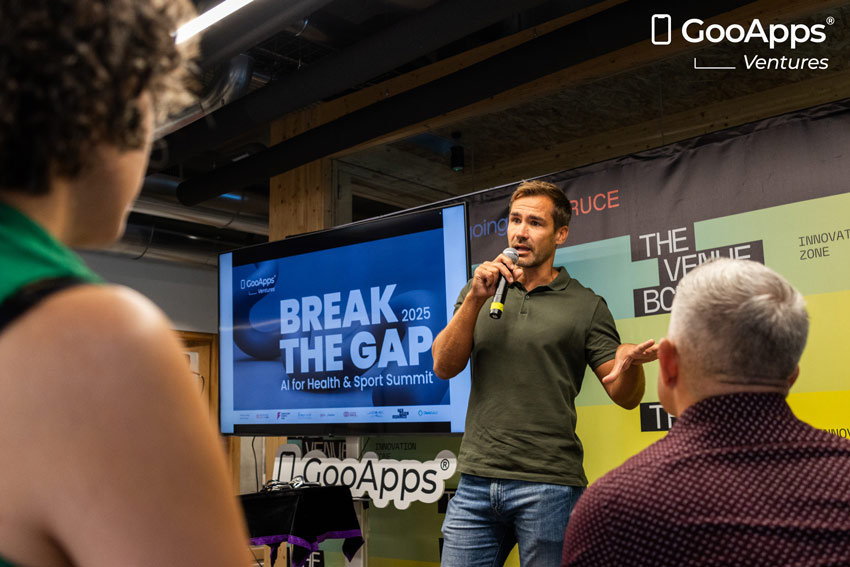
Daniel Duemig
Finally, Xavier Trallero Guillot, representing the Barcelona Sports Hub, reminded the audience that this hub is an initiative promoted by the Barcelona City Council and Indescat, the Catalan sports cluster. He pointed out that it already brings together more than 170 startups and 600 members, and that its mission is to drive business competitiveness in the sports sector. Xavier made it clear that “we love initiatives like this, where we can see projects that break the status quo and truly innovate in sports.”
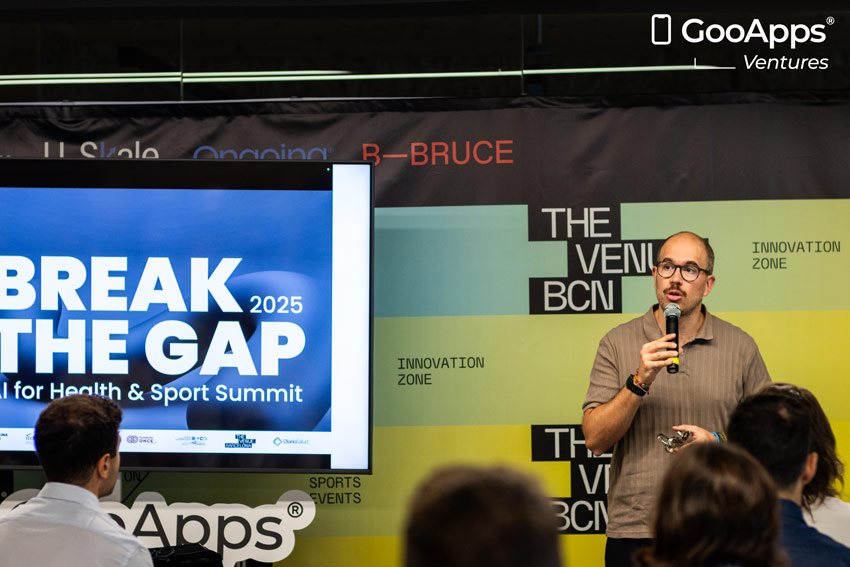
Xavier Trallero Guillot
The tone of the welcome left a shared idea: sports need useful and scalable technology, but also spaces such as Break the Gap that facilitate connections between startups, hubs, clusters, and investors.
The four sports finalist projects surprised everyone
After the institutional welcome, the pitches of the four finalist teams of the sports vertical took place. Each project reflected a different vision of how technology can transform sports practice.
Sport For All
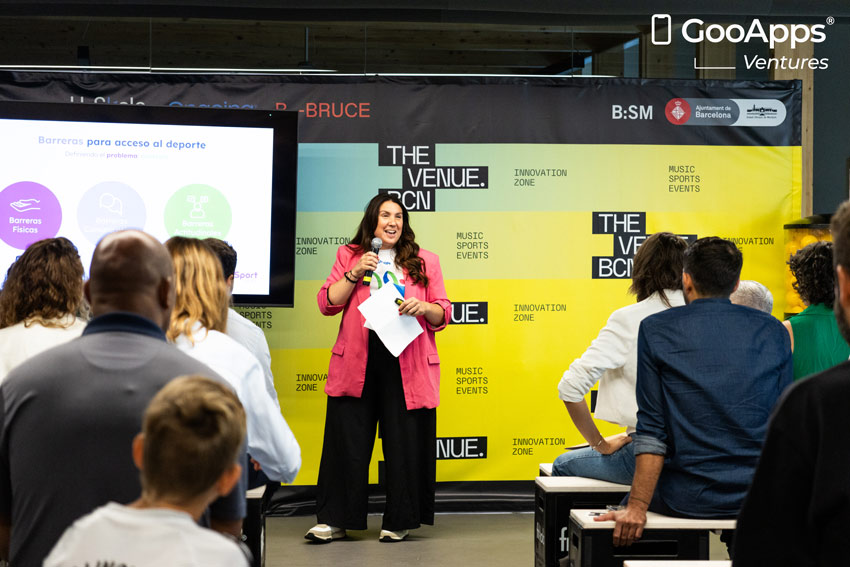
Estefanía Fanjul Moya
The first team to take the stage was Sport For All, a project born with the mission of making sports an activity that is truly inclusive and accessible for everyone, regardless of their physical, social, or economic condition.
The project is led by Estefanía Fanjul Moya, president of the Asociación Sin Límites and head of the organization’s training and awareness programs, together with a committed team that works daily to make inclusion a reality. Their work has been recognized with several national awards for the promotion of inclusive sports, social innovation, and equal opportunities in the physical-sports field.
During the pitch, they emphasized that the lack of specialized training is one of the main obstacles preventing sports from becoming truly universal. With Sport For All, any coach or club can access training modules, practical guides, and adapted activities to work with diverse groups, such as people with disabilities, young people at risk of social exclusion, or older adults seeking to remain active.
The solution also offers an inclusive certification seal, which recognizes organizations that complete the program and apply its methodologies. In this way, they aim to both train and create a quality standard that encourages more organizations to join.
In the words of Estefanía Fanjul, during her presentation: “We believe that sports should be a right, not a privilege. Our platform gives coaches and clubs the necessary tools to make it possible.”
Oncologym
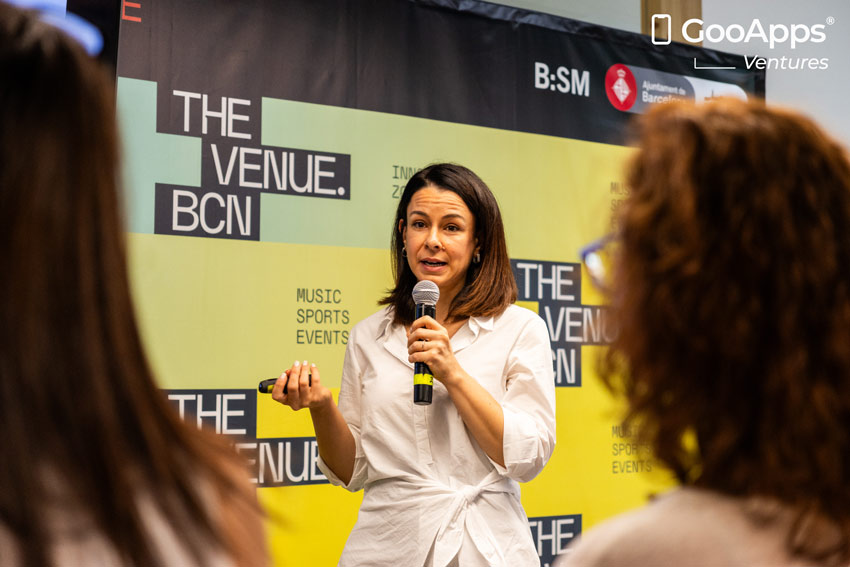
Emanuela Sotgiu
The second finalist team was Oncologym,
a proposal that combines physical exercise, nutrition, and emotional support to improve the quality of life of people going through an oncological process. Their approach is based on the premise that sports and healthy habits are an essential therapeutic ally when safely integrated into the treatment of cancer patients.
The team is led by Emanuela Sotgiu, a professional in the field of oncological exercise and wellness, and Ángel Meléndez,
with experience in innovation applied to the healthcare sector. Together, they have supported more than 300 patients over the last two years, validating the effectiveness and acceptance of their method. They designed a digital program that combines three pillars: adapted workouts, personalized nutritional plans, and psychological support tools.
During the pitch, they explained that the Oncologym platform uses artificial intelligence to adjust exercise routines and nutritional guidelines for each patient according to their medical history, treatment phase, and physical condition. This ensures that the activity is safe and beneficial, avoiding risks and enhancing the positive effects of exercise.
The application also provides a monitoring channel for doctors and specialists to track the patient’s progress, as well as a community space where users can find emotional support by sharing experiences.
Emanuela Sotgiu explained in her presentation: “We want cancer patients to feel that they are not alone and that they have in their hands a safe tool to take care of themselves in a comprehensive way.”
10Mets Longevity
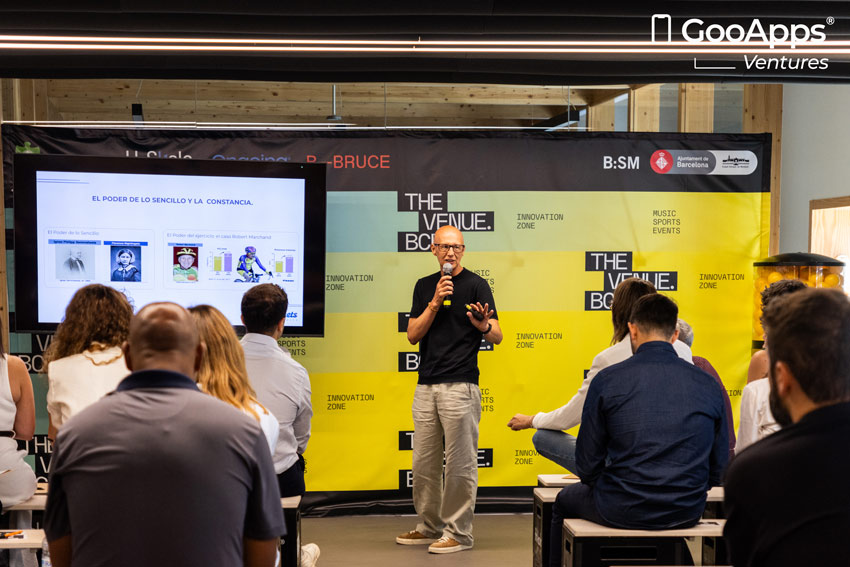
José Manuel Amado
The third finalist team was 10Mets Longevity, a project based on the scientific evidence that links supervised high-intensity physical exercise with an increase in the number of healthy years of life. Their proposal seeks to bring this knowledge into people’s daily lives through a digitized clinical-sports program.
The development team is composed of leading figures in physiotherapy, sports medicine, and health management, including Miguel Aragón (CEO), José Manuel Amado, Pedro Iglesias, Jesús Lafuente, José Carlos Rodríguez (Chief Financial Officer), and Yaiza Taboada (PhD in physical exercise and health). Together, they work to promote active longevity and quality of life.
During the pitch, they explained that the concept of “10 METs” (metabolic equivalent of task) represents the threshold above which medical literature demonstrates clear benefits in terms of reduced cardiovascular risk and increased life expectancy. With their platform, anyone can access tailored routines supervised by professionals, adjusted to their initial physical condition, with the goal of reaching and maintaining that safe performance level.
The solution includes a real-time monitoring system using wearable devices, which transmit data on heart rate, oxygen consumption, and perceived exertion to a clinical panel. From there, the medical team can adjust workloads and prevent risks during sessions.
José Manuel Amado pointed out that the project’s objective is: “exercise prescription based on clinical evidence in order to gain years of healthy life.”
TwinH
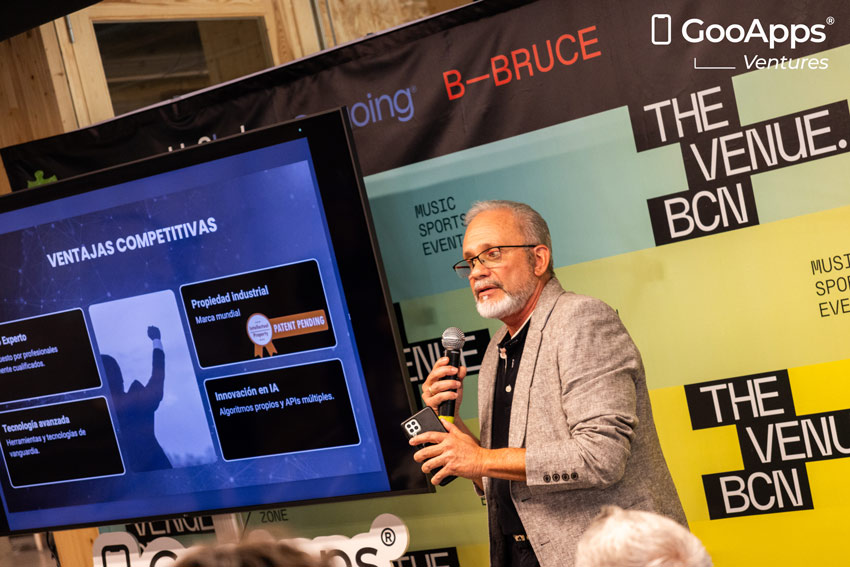
Manuel Benítez Pérez
The last finalist project was TwinH, an initiative that proposes the creation of a human digital twin to personalize training and optimize sports performance. Their approach combines advanced biometrics, motion analysis, and artificial intelligence to offer each athlete a virtual model that replicates their body and activity patterns.
The team is led by Manuel Benítez Pérez (CEO), a tech entrepreneur with experience in patent creation. He is joined by Licet Elisa Leyva González (CMO), with a background in digital marketing and brand positioning, José Carlos Abraham Ravelo (CTO), an AI expert, and Sonia Beatriz Franco Kile
(COO), focused on systems and operations. This mix of profiles allows them to cover everything from clinical data collection to practical application in training programs and injury prevention.
In their pitch, the team explained how TwinH generates a unique digital model for each athlete from physiological parameters (heart rate, strength, endurance) and biomechanical data captured through sensors and wearables. With this information, the platform creates simulations that allow:
- Adjusting training routines in real time.
- Detecting risk patterns that could lead to injuries.
- Measuring progression and comparing physical load scenarios safely.
They also emphasized that the system is designed both for elite athletes and for amateur users who want to train with scientific rigor, since the digital twin adapts to different levels of demand.
Manuel Benítez stated: “Our digital twin is not science fiction; it is a practical tool to train better, prevent injuries, and extend athletic careers.”
Two masterclasses to conclude the sports final
After the project presentations and the networking breakfast, the sports final included two keynotes designed to inspire the teams and the rest of the audience.
Breaking grass ceilings: leadership and innovation with an impact on sustainability
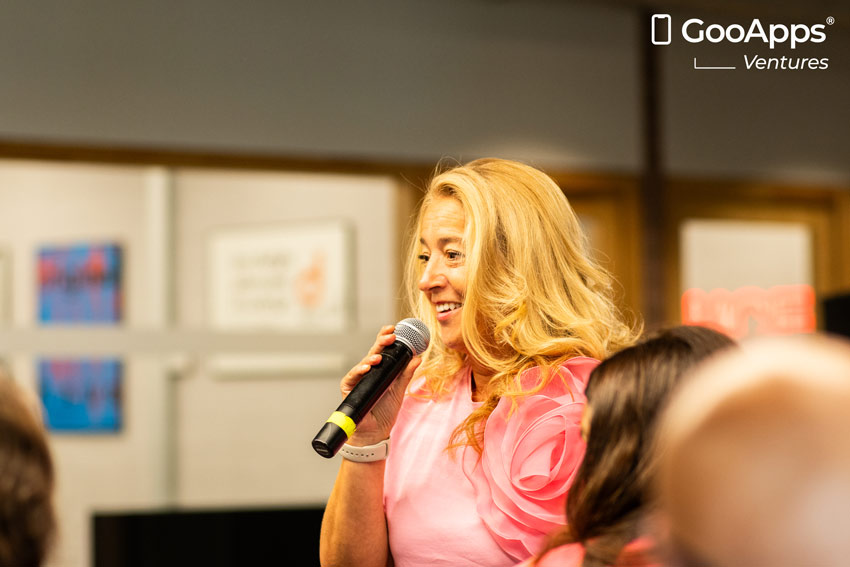
Leonor Gallardo
The session was led by Leonor Gallardo, director of the IGOID research group and CEO of SPORTEC, one of the most recognized voices in sports management in Spain. Her presentation focused on how sports can and should become a driver of social transformation through innovation, sustainability, and female leadership.
Gallardo began by presenting a striking figure: 80% of sports facilities in Spain were built more than 20 years ago, which represents a major challenge in terms of energy efficiency and sustainability. Faced with this context, she argued that it is time to embrace circular economy models that make it possible to modernize these infrastructures while reducing costs and environmental footprint.
In parallel, she stressed the need for more women to occupy leadership positions within the sports and technology ecosystem. She recalled that female talent continues to be underrepresented in management roles and that without their active participation, it will be difficult for the sector to advance toward a more inclusive and balanced model.
Among the messages she left with the audience, she highlighted the importance of:
- Embracing technological innovation to optimize resources in sports facilities.
- Measuring environmental and social impact in every business decision in sports.
- Promoting female leadership as a lever for competitiveness and cultural change.
In her own words, Leonor Gallardo stated: “Sports cannot be limited to generating entertainment. It must lead the transition toward a sustainable model, and it must do so with more women at the forefront.”
Her intervention was met with applause and served as a reminder that innovation in sports is not only measured in economic results, but also in the impact it generates on society and the planet.
Public funding for sports startups
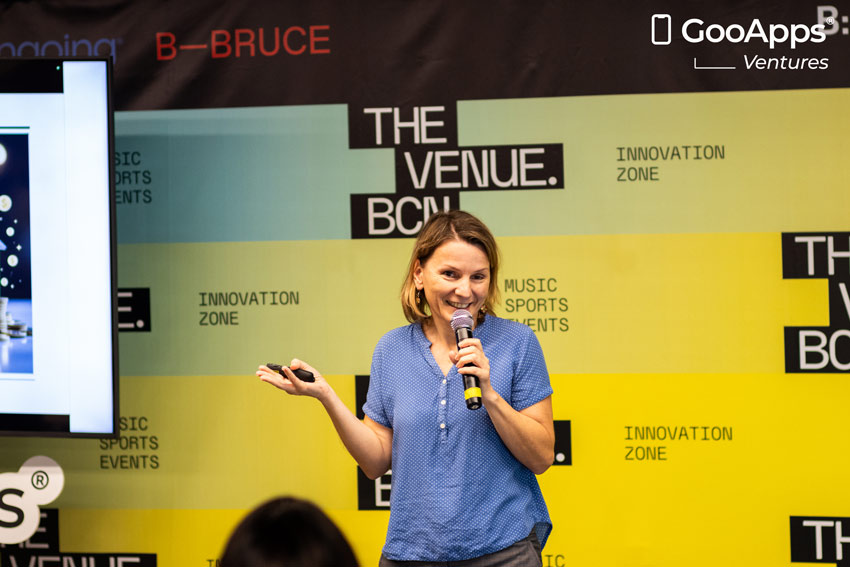
Ela Goralska
The second keynote of the day was given by Ela Goralska, director of Redinnova Consulting, specialized in obtaining public funding for innovative projects. Her presentation focused on showing how sports startups can access non-dilutive financial resources that, in many cases, are decisive in overcoming the early stages of development.
Ela began by explaining the difference between private and public funding, pointing out that too many startups rely solely on external investors and are unaware of the multiple calls open at local, national, and European levels. She emphasized that these funds provide not only capital, but also visibility and credibility in the eyes of strategic partners and potential clients.
Throughout her presentation, she provided a practical overview of the main instruments available for sports startups:
- National grants focused on technological innovation and digitalization projects.
- European funds, especially the Horizon Europe and EIT programs, which finance international innovation consortia.
- Regional aid linked to sports clusters and social impact projects.
In addition, she shared recommendations to increase the chances of success in these calls: having a solid business plan, presenting clear impact metrics, and, above all, aligning the project with the strategic priorities of each program.
The keynote concluded with a motivational message: startups that manage to combine private investment with public funding multiply their chances of survival and growth. For the finalist teams, it was a call to diversify their sources of capital and to consider the public route as a resource as strategic as private investment.
Another €50,000 for the winning sports project
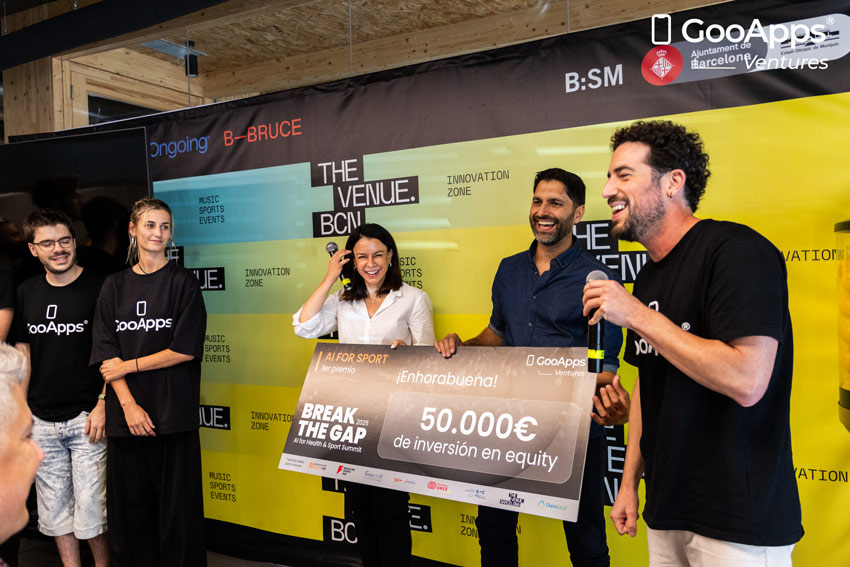
After the round of pitches, the jury withdrew to deliberate. As in the health final, the decision had to be based on the five established criteria: problem, viability, pilot, scalability, and team. The four projects showed a high level of innovation and commitment, which made the evaluation intense and thorough.
However, there was consensus that one of the projects stood out for its comprehensive vision, capacity for clinical implementation, and direct benefits for patients.
The jury chose Oncologym as the winner of the sports vertical, granting it the €50,000 equity investment from Goo Ventures. The decision was supported by several factors: the multidisciplinary backing of the team, the preliminary validation of its proposal, and the fact that its solution addressed an urgent and universal need: supporting people undergoing an oncological process.
When the result was announced, the Oncologym team received a warm round of applause. Amid the excitement, Marta Delgado, sports nutrition specialist of the group, took the floor:
“This award allows us to bring Oncologym to more patients and to demonstrate that sports, nutrition, and emotional support are necessary allies in the fight against cancer.”
The atmosphere in the auditorium was one of shared enthusiasm. The rest of the finalists also received recognition from both the jury and the audience, with the feeling that Break the Gap 2025 had been a launching point for all the teams, regardless of the final outcome.
Lessons learned from Break the Gap
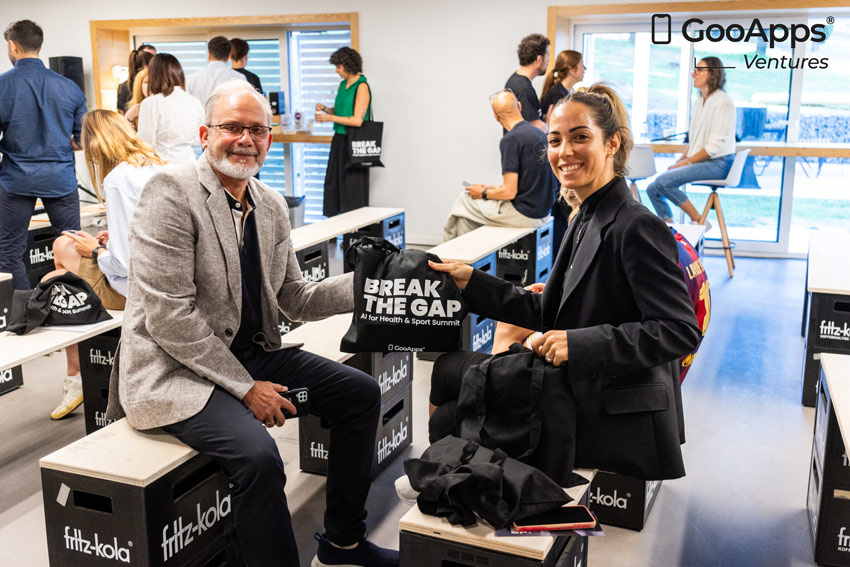
The Break the Gap: AI for Health & Sport Summit demonstrated that it is not just a startup competition. As Eric García reminded everyone during the finals: “Break the Gap is a platform for the meeting of innovation, technology, sports, and medicine to break barriers. Barriers of visibility, gender, and access to opportunities. And our challenge is to ensure that every purposeful idea has a path to reach the market.”
A format that combines two levers to support startups in their projects:
- An acceleration program valued at €10,000 for the eight finalist teams, with high-level mentoring.
- An equity investment of €50,000 for the winner of each vertical, provided by Goo Ventures.
But what participants valued most is what happens around this event: access to an active network of hospitals, universities, innovation hubs, sports clusters, and patient associations. Eric García explained: “Here we do not just reward an idea. We build that network that is vital in early stages so that startups can move from concept to market.”
Break the Gap has established itself as a strategic meeting point where projects with social and scientific impact can find the necessary boost to grow.
Goo Ventures: a venture studio with purpose
Behind Break the Gap is Goo Ventures, the venture studio created by GooApps® to accelerate startups in health, sports, and wellness. Its role is not limited to funding, but also to co-creating and co-founding projects with the teams, providing everything necessary to move from idea to market.
Eric explained it clearly:
“Three out of four startups fail. Our goal is to change that statistic with technical and financial support, and with connections that open the necessary doors to reach the market successfully.”
The venture studio offers a multidisciplinary team capable of covering all the phases of a startup:
- Technological development
- Design and user experience
- Regulation and medical certifications
- Business strategy and market access
As Eric said: “To innovate is not a destination, it is a journey. And what matters is to walk that path accompanied.”
The mission of Goo Ventures is to create startups that improve people’s quality of life, providing solutions in health, sports, and wellness. Thanks to its network and execution capacity, it has become a strategic partner for entrepreneurs seeking to transform these sectors.
Do you want to know more about Goo Ventures?
Discover:
An ecosystem in motion
The combination of Break the Gap and Goo Ventures shows that innovation brought to success does not depend solely on entrepreneurial talent. It also requires an ecosystem that provides resources, mentoring, investment, and strategic connections. That is the essence of the proposal: to accompany startups from the idea stage to their implementation in the market, ensuring that innovation reaches where it matters most—hospitals, sports centers, and, most importantly, people.
The future of Break the Gap: This is only the beginning
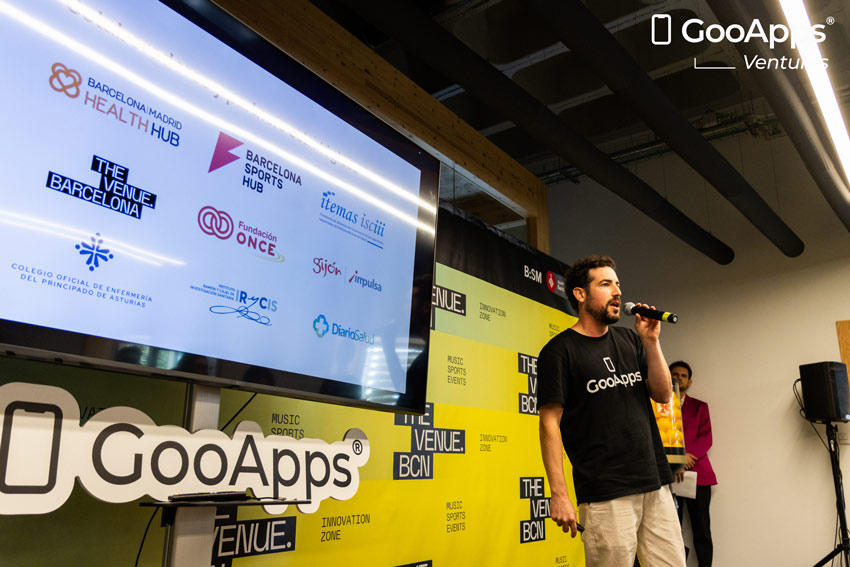
Eric García, CEO of GooApps® and Goo Ventures
The finals of Break the Gap 2025 made it clear that the event has taken a qualitative leap compared to its first edition. With two independent verticals, health and sports, eight finalist projects, and an increasingly broad ecosystem filled with renowned entities, the initiative has established itself as a benchmark platform in applied innovation.
The message that remained after the event was that innovation brought to success is only possible if it is built in a network. Startups, hospitals, universities, sports clusters, investors, and public institutions demonstrated that when they connect, ideas find faster and more effective paths to reach the market.
Looking ahead, Break the Gap will continue to evolve. The shared vision of GooApps® and Goo Ventures is to open this space even more to new startups and to continue adding collaborating entities that will boost the HealthTech and SportsTech ecosystem.
That is why next year’s edition is already underway and will take place in an idyllic Caribbean location!
Stay tuned for updates on Break the Gap 2026 Caribbean!
